New scientific research confirms Irish provenance of manuscripts on loan from Switzerland, returning to Ireland for the first time in a millennium. The new exhibition also features more than 100 objects from the medieval world from which the manuscripts emerged, many on public display for the first time.
"Words on the Wave: Ireland and St. Gallen in Early Medieval Europe", a major exhibition focusing on early medieval Ireland and its profound impact on ideas in Europe, will be launched at the National Museum of Ireland, Kildare Street on May 30. The President of the Swiss Confederation, Karin Keller-Sutter and the Irish Minister for Arts, Culture, Communications, Media and Sport, Patrick O’Donovan, will preside over the launch.
At the exhibition’s heart are 17 manuscripts on loan from the Abbey Library of St. Gall in Switzerland, a seventh-century library, in a city named after the Irish monk, St. Gall, that is home to one of the world's most significant collections of early medieval manuscripts. This exhibition is a world-first, marking the largest-ever loan of these manuscripts.
These priceless, handmade manuscripts reflect the journeys of Irish monks like St. Gall and St. Columbanus, who travelled to Europe seeking exile, refuge, and learning. Their journeys involved not only the movement of people but also ideas and artistic traditions, connecting the small island of Ireland to a much larger continent. It mirrors a 1,400-year-old connection between Switzerland and Ireland that started with the arrival of St. Gall in St. Gallen in 612.
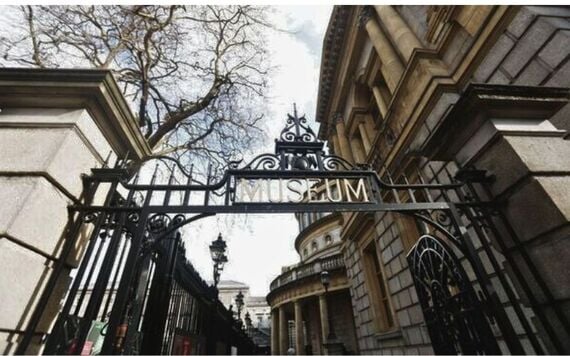
The National Museum of Ireland, on Kildare Street, in Dublin.
Groundbreaking scientific research
New research commissioned by the National Museum of Ireland for the exhibition, using advanced scientific techniques, has provided evidence for the first time that the four most decorated manuscripts on loan from the Abbey Library of St. Gall were made using the hides of Irish cattle. While the role of Irish monks in writing the manuscripts was already known, this research reveals that the books travelled from Ireland to St. Gallen with them, on their journey over a thousand years ago.
Read more
Employing techniques such as X-ray fluorescence (XRF) and multispectral imaging in both ultraviolet and infrared spectrums, researchers working with University College Cork’s Inks and Skins project were able to identify elemental components of the inks, pigments, and parchment, many of which are not visible to the naked eye.
The analysis revealed that the manuscripts were written with iron gall ink made from the nests of wasps in oak trees, a distinctive and well-documented feature of Irish manuscript production during the early medieval period.
Furthermore, the method by which the animal skins were prepared, along with the presence of specific chemical elements such as sulphur and potassium, closely aligns with known Irish techniques of parchment manufacture. The Inks and Skins project team also collected surface DNA samples from the manuscripts to identify the genomes in the skins of the cattle used in their production.
Scientific analysis of this DNA conducted by the School of Genetics in Trinity College Dublin indicates that the cattle were of Irish origin. Using a technique pioneered by the team in 2017— a non-invasive genetic analysis of the parchment on which the manuscripts are written, in which DNA is gently extracted from the surface of manuscripts using a rubber eraser—the team successfully recovered genetic material from the animal skins used in manuscript production. The results, interpreted using Principal Component Analysis (PCA), demonstrate that the cattle, from whose skin the parchment was made, were of Irish origin.
Rare and priceless manuscripts
Amongst the 17 manuscripts on display are the following:
Isidore’s Etymologiae —Isidore was a cleric in Spain who wrote a 20-volume encyclopedia in the 7th century about the meaning of words. The exhibition will feature small parts of a copy written by an Irish person not long after it was first written. Considered an 'internet' of the ancient world, this is the earliest known fragment of this book in existence.
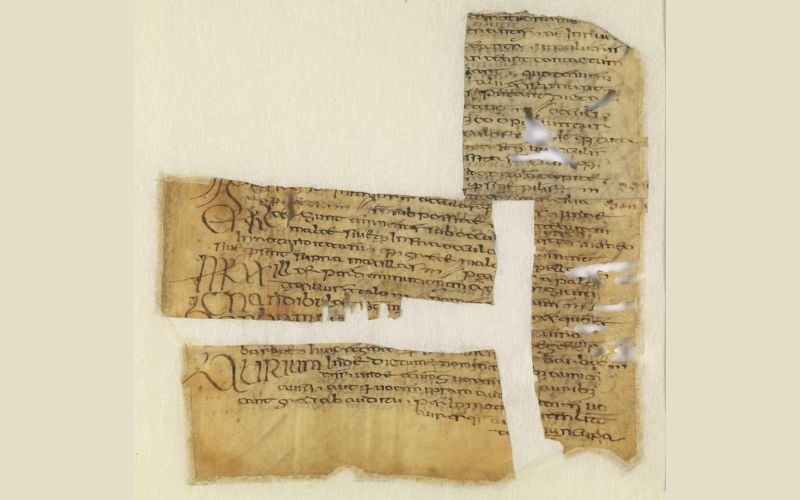
Isidore’s Etymologiae.
Priscian’s Institutiones Grammaticae — a Latin grammar book unique for the thousands of scribbles in the margins by the monks in the Old Irish language. The translations of Latin into Old Irish were essential in reconstructing the heritage of our national tongue. Visitors can get a glimpse into the everyday thoughts of these monks through their doodles, witty banter, and grumbles about the Vikings, hangovers, and the quality of the ink in the margins of the manuscript. A moving poem describes the feeling of a scribe in the woods. This was probably written in the monasteries of Nendrum or Bangor in the North of Ireland but was on the Continent within a decade of being written.
Irish Gospels of St Gall (Cod.Sang 51) - This mid-8th-century book is one of the rarest in the world and shows the power of writing and art in Ireland during the period. The manuscript features vibrant and striking portraits of the Evangelists, vivid scenes of the Crucifixion and the earliest depiction of the Last Judgement, and intricate designs that echo Irish metalwork, stone crosses, and other illuminated manuscripts from the Irish midlands. Closely related in style and origin to the Faddan More Psalter — also on display — it reflects the spiritual, artistic, and scholarly world of early medieval Ireland
Vellum Reliquary label- Dating to c. 700 AD, this small but significant label from the Archives of the Abbey of Saint-Maurice, Switzerland, contains the earliest known written reference to St Brigid and is direct evidence for Irish pilgrims traversing the Alpine pass en route to or from Rome.
Read more
Artefacts from the world
The manuscripts will be displayed alongside over 100 extraordinary objects from the world in which they emerged, many of which are on display for the first time. These include early medieval objects from Meath, Westmeath, Limerick, Dublin, Donegal, and Kerry.
The Lough Kinale Book Shrine is Ireland’s oldest and largest container for a sacred book. Found broken at the bottom of a Longford Lake and conserved at the National Museum of Ireland in a complex process over many years, this is the first time it has gone on public display.
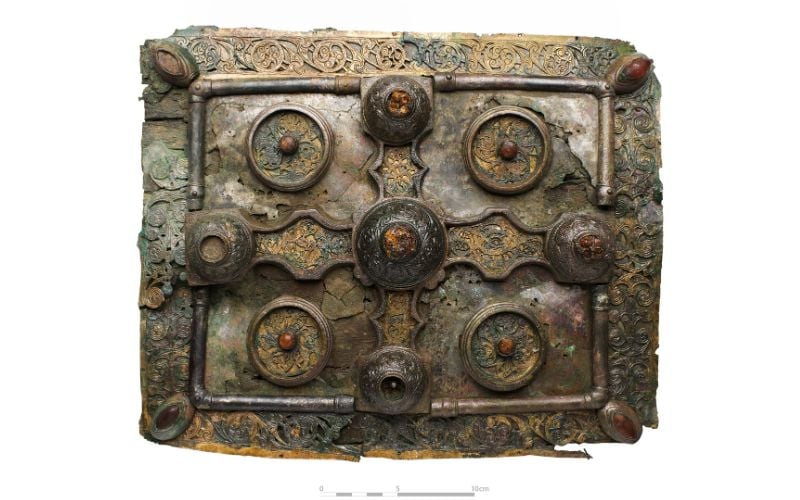
The Lough Kinale Book Shrine.
The recently discovered Ardshanbally Brooch, found near Adare in Co Limerick, dating from the 8th-9th century, will also be on display for the first time.
A Viking sword found in 2018 in the River Shannon at Limerick, on display also for the first time, is of the very type that struck fear into the hearts of an Irish scribe who wrote in one of the St. Gallen manuscripts about his relief at stormy seas, knowing the Vikings could not traverse these dangerous waters. This prestige weapon is decorated with glittering silver and copper wire.
A leather shoe recently excavated at Mungret Co., Limerick, is of the type worn by St. Matthew as depicted in a fragment of the Abbey Library of St. Gall. New research conducted for this exhibition confirms that this type of shoe was common in Ireland when the manuscript was illustrated.
A coin minted in York is the first copper-alloy Northumbrian coin, and one of the earliest English pennies ever to be found in Ireland. It was discovered in 2023 during excavations in advance of a housing development near Ballyfermot in Co. Dublin, and it is thought to have arrived in Ireland in the hands of a Viking.
The only Irish manuscript ever found in a bog—the Faddan More Psalter.
Discovered in a Tipperary bog in 2006, the Faddan More Psalter’s papyrus-lined cover provides rare and direct evidence of contact between early medieval Ireland and the Mediterranean world over a thousand years ago — the first discovery of its kind not just in Ireland, but anywhere in the world.
The Rinnagan Crucifixion Plaque from Athlone, Co. Westmeath, dating to the 8th–9th century. Made of beautifully cast bronze, it depicts the Crucifixion in a style similar to that found in the St. Gall manuscripts.
Words on the Wave: Ireland and St. Gallen in Early Medieval Europe is a once-in-a-lifetime opportunity to see these precious treasures from Ireland’s Golden Age exhibited together. It will be on display in the National Museum of Ireland, Kildare Street, from May 30th until 24th October. Admission is free.
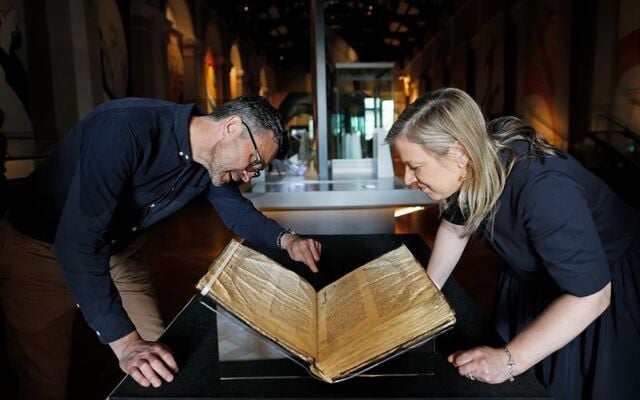

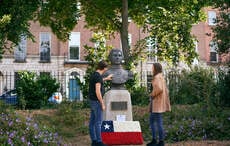

Comments